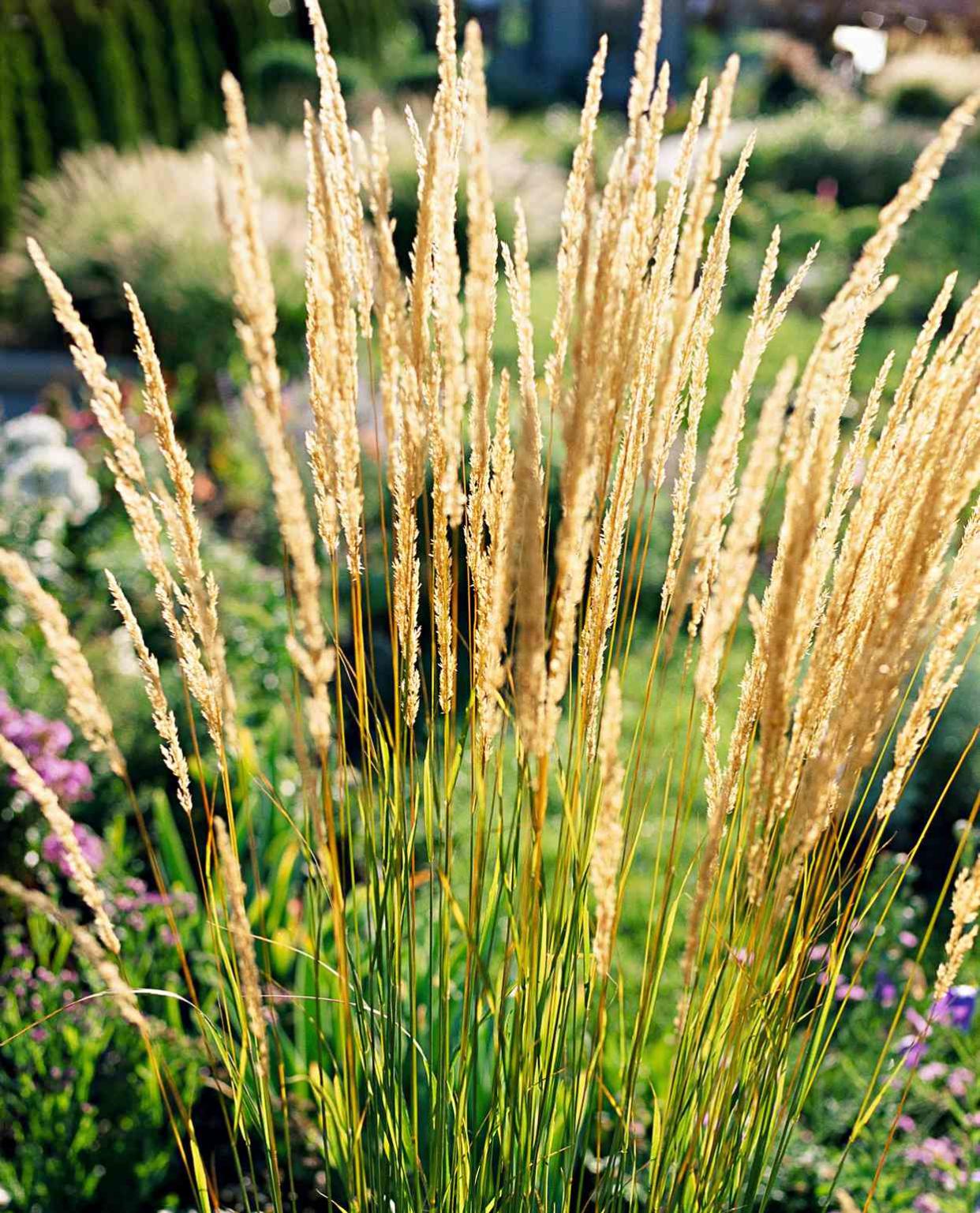How to Plant and Grow Feather Reed Grass

While other ornamental grasses tend to arch outward, feather reed grass forms dense, erect clumps of narrow green leaves that send up stiff flowering stalks in the summer. The narrow blossoms open slightly to become feathery plumes of seed heads in the fall that wave softly in the breeze. The seed heads look also great in cut-flower arrangements. The plants will often hold onto the plumes past fall, which adds wonderful winter interest to a garden.
This tall ornamental grass adds a stunning vertical architectural element to a landscape, even in winter. Industrial areas like street medians and parking lots often feature this plant because it’s easy to grow and doesn’t require much maintenance to retain its sculpted appearance.
Where to Plant Feather Reed Grass
The ideal location for feather reed grass is where it gets sun in the morning and light shade during the hot afternoon hours. It does not have any specific requirements in terms of soil quality or texture. It grows in moderately acidic to alkaline soil.
With its tall, narrow stalks, feather reed grass looks best mixed in among other perennials and even other grasses.
How and When to Plant Feather Reed Grass
You can plant feather reed grass in the spring or fall. Dig a hole twice the width of the root ball and with a depth a little less than the height of the root ball. Place the grass in the hole and backfill the hole with soil. Water it well and keep it moist until the grass is established.
Space plants 2 to 3 feet apart.
Feather Reed Grass Care Tips
Light
Feather reed grass is a cool-season grass that can grow in full sun but does best with some afternoon shade, especially in a warm climate. In too much shade, however, it becomes floppy.
Soil and Water
Feather reed grass is one of few ornamental grasses that tolerates moist to almost wet soils. This makes these plants a great option for rain gardens or boggy areas. And unlike many of the other ornamental grasses, it does well in heavier clay soils. The pH should be between 6.0 and 8.0.
Plant this grass in well-drained, fertile, rich soil that remains consistently moist. Once established, feather reed grass can tolerate occasional droughts.
Temperature and Humidity
Feather reed grass is a cool-season grass that can survive subzero winters down to zone 3 but does not do well in hot climates. It can tolerate humidity if there is sufficient air circulation around the plant.
Fertilizer
Generally, feather reed grass does not need much fertilizer but if it’s planted in poor, infertile soil, it benefits from a springtime application of a complete slow-release granular fertilizer. For the amount to use, follow product label instructions.
Pruning
Because of its sturdy upright growth, feather reed grass adds a dramatic accent to winter landscapes, especially when its plumes are left intact. Don’t cut it back in the fall; instead, wait until late winter or early spring to cut it back 2 to 3 inches above the crown to make room for new growth.
Potting and Repotting Feather Reed Grass
Feather reed grass makes a good container plant if you keep it in a location where it is protected from strong winds and cannot get knocked over. Plant it in a container with large drainage holes and filled with a combination of potting mix and compost. Keep in mind that potted plants, unlike plants in the landscape, need frequent watering and fertilizer.
Repot the grass in a larger container with fresh potting mix and compost when the clump has filled the container.
Pests and Problems
The grass is not bothered by any serious diseases or pests. In wet weather conditions, it might be affected by rusts. These plant diseases caused by fungi usually disappear when the wet period is over. Feather reed grass is relatively deer-proof.
How to Propagate Feather Reed Grass
Like other ornamental grasses, feather reed grass is propagated by division (the seeds are sterile). Divide this grass in early spring, if desired, just as new growth emerges. If you haven’t done so already, shear off last year's growth. Using a spade, slice into the soil about an inch or so away from the clump and make a slice straight down through the clump to cut off a manageable section of the clump. Lift it out of the ground with all its roots and replant it in a new location at the same depth as the original plant.
Types of Feather Reed Grass
Foerster's Feather Reed Grass
Calamagrostis x acutiflora 'Karl Foerster' is a variety that was named perennial plant of the year in 2001. Initially rose-colored and later brown feathery flower spikes arise above clumps of green foliage 18 to 24 inches tall. Zone 4-9
Overdam Feather Reed Grass
Calamagrostis x acutiflora 'Overdam' is a cultivar whose foliage has variegated yellow margins and red-brown, feathery summer plumes that turn a golden in the fall. The stalks can reach a height of 6 feet. Zone 4-9
Avalanche Feather Reed Grass
Calamagrostis x acutiflora 'Avalanche' is another variety with variegated foliage. The foliage has white centers and green margins. The stalks turn golden in the fall and the colorful plumes last into the winter. It grows 3 to 4 feet tall and 1 to 2 feet wide. Zone 4-9
Frequently Asked Questions
Is feather reed grass invasive?
Feather reed grass is a hybrid between an Asian and a European grass species. It produces sterile seeds, which means the plants can’t spread by seed and become invasive.
Does feather reed grass flower?
In the summer, tall spires of narrow blossoms appear in shades of tan, green, white, and sometimes pink, depending on the variety.
For more Better Homes & Gardens news, make sure to sign up for our newsletter!
Read the original article on Better Homes & Gardens.

